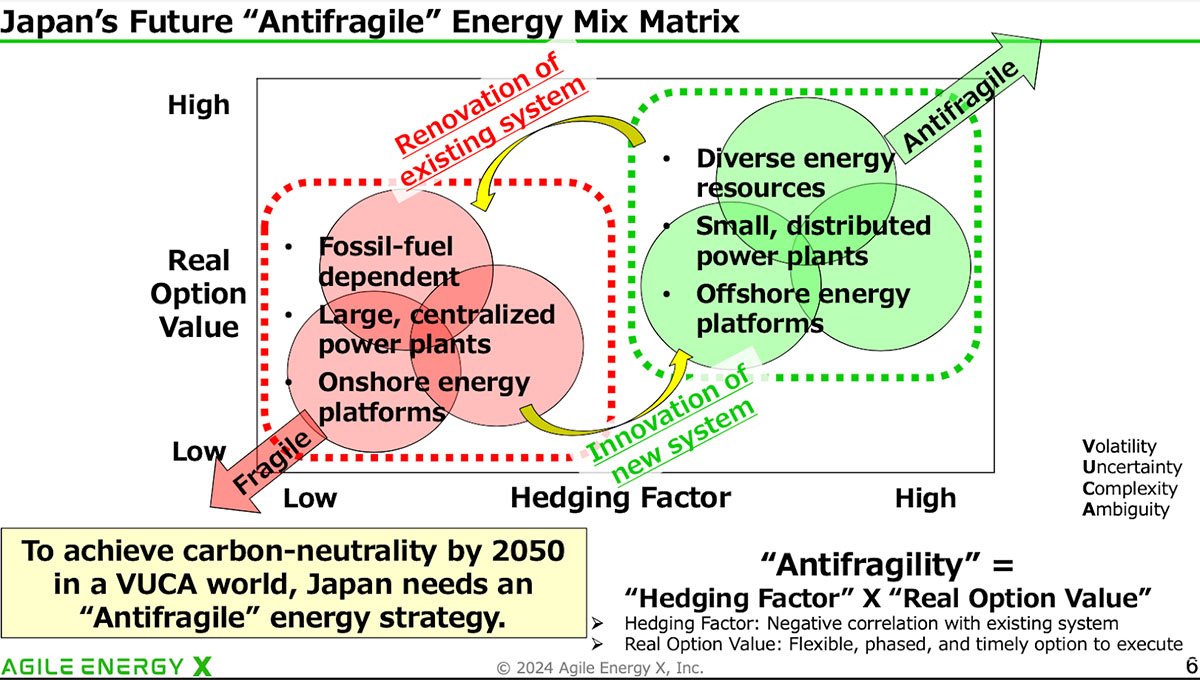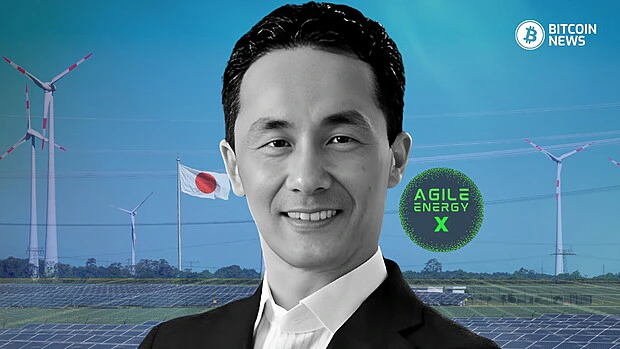A transformative shift is unfolding in Japan, spearheaded by Agile Energy X, a subsidiary of TEPCO Power Grid. CEO Kenji Tateiwa is redefining the nation’s approach to energy infrastructure.
In an exclusive interview with BitcoinNews, he explained that by leveraging Distributed Energy Resources (DER) and innovative computing solutions, the company aims to create a flexible and resilient energy network.

Japan’s energy woes are no secret. With a primary energy self-sufficiency ratio of only 13.3% in 2021, the nation’s power grid teeters on the edge of vulnerability. Agile Energy X aims to address this fragility with an unlikely ally: Bitcoin mining.

The core idea is to use variable renewable energy sources to power portable, distributed energy facilities.
These facilities can flexibly create power demand, turning surplus energy into a valuable resource. The mission extends to promoting local production and consumption of electricity by tapping into stranded energy resources in previously unprofitable regions.

Bitcoin mining stands out as one of the most effective demand response tools due to its unique flexibility. Tateiwa describes it as a process that converts power (MW) directly into digital value (MH: Hash value).
This characteristic allows Agile Energy X to swiftly adjust mining activities in response to fluctuating energy supply, contributing to a more resilient and adaptive power system for Japan.
Related: Canada, Texas, And Paraguay Are Changing The Narrative On Bitcoin Mining
What sets Bitcoin mining apart as an optimal energy buyer is its unparalleled adaptability. The process can be likened to a global lottery with draws occurring every 10 minutes, where miners are constantly making guesses.
Each 10-minute round is independent, allowing miners to activate or deactivate their machines without impacting their overall chances of success in future rounds.
When miners successfully find a block by making the right guess, they receive the block subsidy and transaction fees, also known as the coinbase reward.
Importantly, previous participation or duration of play doesn’t influence the odds of finding a block, enabling Bitcoin miners to turn machines on or off without “penalty.”
This flexibility is unique to Bitcoin mining. In contrast, AI data centers, often touted as potential energy buyers, don’t offer the same adaptability. AI model training is more like baking a complex cake.
Once you start the process, you can’t simply turn off the oven halfway through without risking the entire outcome.
The continuous processing of large datasets is crucial, and interruptions can disrupt the learning process and potentially invalidate progress. This makes Bitcoin mining a far more flexible and responsive tool for managing variable energy supplies.
Interestingly, Tateiwa noted that some battery manufacturing companies view Bitcoin miners as competitors. However, he believes this perspective is flawed.
Batteries and Bitcoin mining are not mutually exclusive and, in fact, they can work in tandem. Once batteries are charged, an energy producer can switch to Bitcoin mining.
Energy companies should use every resource at their disposal to improve the grid. This holistic approach underscores Tateiwa’s belief that viewing Bitcoin miners as competition to batteries is a misunderstanding of the technology’s potential.
Agile Energy X’s approach is refreshingly pragmatic.
When meeting with skeptical politicians and executives, the company avoids focusing on the philosophical aspects of Bitcoin. Instead, they highlight the pragmatic challenges of renewables and how Bitcoin mining addresses some of these issues:
- Curtailment of renewable power could reach 42% by 2050 if Japan were to achieve carbon neutrality.
- Grid congestion is strangling new renewable projects in many areas.
- Bitcoin mining can create instant, flexible demand for excess power.

The results speak for themselves. In Gunma prefecture, a 50kW solar-power-tracking containerized data center is already operational.
This project demonstrates how Bitcoin mining can contribute to avoiding interconnection delays of renewable energy due to grid congestion and reduce opportunity costs caused by curtailment.
But Tateiwa’s vision extends beyond mining. He’s building what he calls the “Ultimate Circular Economy.”

In the photo above, you can see Tateiwa with a mayor in a small town outside of Tokyo in the top left.
Agile Energy X’s system is remarkable for its ability to repurpose otherwise wasted energy to capture CO2, heat a hydroponic station, feed fish with the byproducts, and even produce tiny diamonds from the captured CO2.
While earning bitcoin is a beneficial side effect, Tateiwa emphasized:
“The point is not to make money out of Bitcoin but to use wasted energy in a way that benefits local communities.”

Using Bitcoin miners to power aquaponics systems, heat vegetables, and feed fish, while employing molten salt electrolysis (which Tateiwa studied during his undergraduate years) to turn CO2 into oxygen and diamonds, showcases the potential of this technology.
These direct air capture systems remove CO2 from the atmosphere like plants, but instead of just producing oxygen, they also create small diamonds. This holistic approach transforms waste products into valuable resources, creating a truly sustainable ecosystem for local communities.
It’s an innovative approach that’s gaining attention. By focusing on tangible benefits and immediate solutions, Agile Energy X is slowly but surely convincing Japan’s power brokers that Bitcoin mining isn’t a threat, but an opportunity.

Tateiwa also points to global trends supporting his vision. Many institutional investors are beginning to include bitcoin in their investment portfolios, positioning it as a legitimate financial asset.
Bitcoin’s market cap has exceeded 1 trillion US dollars, and the global mining capacity is around 19 GW. Even grid operators in renewable energy-rich regions, like ERCOT in Texas, are welcoming Bitcoin mining as an “off-taker of first and last resort.”
In the face of Japan’s energy vulnerability, Kenji Tateiwa and Agile Energy X are pioneering a revolutionary approach that transforms challenges into opportunities.
By ingeniously integrating Bitcoin mining into the energy infrastructure, they’re not merely addressing immediate power concerns but are architecting an antifragile system that thrives on volatility and uncertainty.
This strategy goes beyond conventional thinking, creating a symbiotic relationship between renewable energy sources, innovative technologies, and local communities.
In the land of the rising sun, Bitcoin mining is heralding the dawn of a new energy era. But it’s more than that; it’s a beacon for global energy innovation.
Tateiwa’s leadership demonstrates that with creativity, pragmatism, and a willingness to embrace unconventional solutions, we can transform our greatest challenges into our most powerful assets.
As Japan charts this course, it offers a compelling model for nations worldwide grappling with energy security and sustainability.










